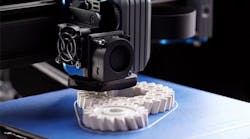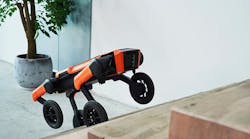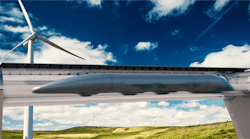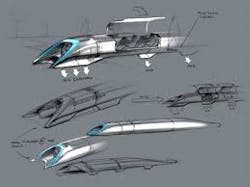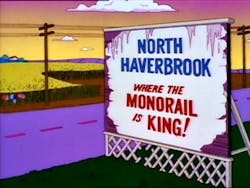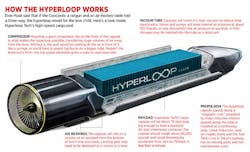The hyperactive mind of Elon Musk, founder of both Tesla Motors and SpaceX, is credited with imagining up the Hyperloop, a totally tubular system that can whoosh passengers from point A to point B at 760 mph. Maybe it was after a double feature of The Simpsons episode "Marge vs. the Monorail" and Futurama's "Space Pilot 3000," seeing as the almost cartoonish idea is a combination of that ill-fated train that bankrupted poor ol' North Haverbrook and New New York's Tube Transport System. Or maybe Musk possesses that rare type of daVincian foresight to make the future now.
A conceptual design of a hyperloop train car. Image: SpaceX
However it was conceived, this Musk brainchild will not be raised by the South African wunderkid. Musk is too busy with Gigafactories and spaceships, after all. (SpaceX did however hold a pod design competition won by MIT students recently, though.) He open-sourced his concept in 2013 in a 57-page white paper for some other billionaire genius to build.
The design includes a front-end compressor fan to eliminate air resistance, a vacuum tube with valves and pumps to reduce drag, and the same linear induction motors used with maglev trains. The hyperloop concept will now be fostered by several different groups. Late last month, one of these groups, Hyperloop Transportation Technologies (HTT), a crowdsourced company comprising more than 200 engineers and designers from Silicone Valley to the the Ivy League, made major headway by filing construction permits in Kings County, Calif., located between San Francisco and Los Angeles.
photo credit: GROW Holdings, LLC
photo credit: simpsons.wikia.com
That act couldn't sound more boring, but it's the first step to the first hyperloop.
"After two and a half years of research and development our team has reached another important milestone. This will be the world's first passenger-ready Hyperloop system," company CEO Dirk Ahlborn said. "Everyone traveling on California's I-5 in 2016 will be able to see our activities from the freeway."
Don't expect those freeways to become obsolete overnight, though. Principle construction won't begin until spring. Current site preparations in Quay Valley, the 7,200-acre, 25,000-home sustainable community which the Hyperloop will wrap around, include geotechnical investigations for pylon placement and soil sampling. After the ground survey is done, drones will map the region to mark how the track snakes through the corridor, and where the pylons and stations should go.
The track is slated for public use in the 100% solar-powered city as early as 2018.
infographic credit: forbes.com
If the thought of super rich Silicon Valley types speeding around the most aggressively environmentally friendly city in the world doesn't get you excited, what if we told you that same tech could be used in industry?
Hyperloop Technologies, led by a former SpaceX engineer, Brogan BamBrogan and venture capitalist Shervin Pishevar, a prominent Uber investor, have a pipe dream to speed up the supply chain to Sonic the Hedgehog levels. In their theoretical system, 70-foot capsules housing 40-foot containers would travel at 750 mph across water or land.
A 3-km prototype test track is being built on 50 acres north of Las Vegas and should be ready in the next few months.
It's too early to tell if gambling on an idea Musk himself hasn't made a priority will lead to the transportation of the future or become just a tube to nowhere, the hyperloop, which could cost at least $20 million per mile, according to HTT, is happening.
As Bart Simpson said to his skeptical mom, "Sorry mom, the mob has spoken."
